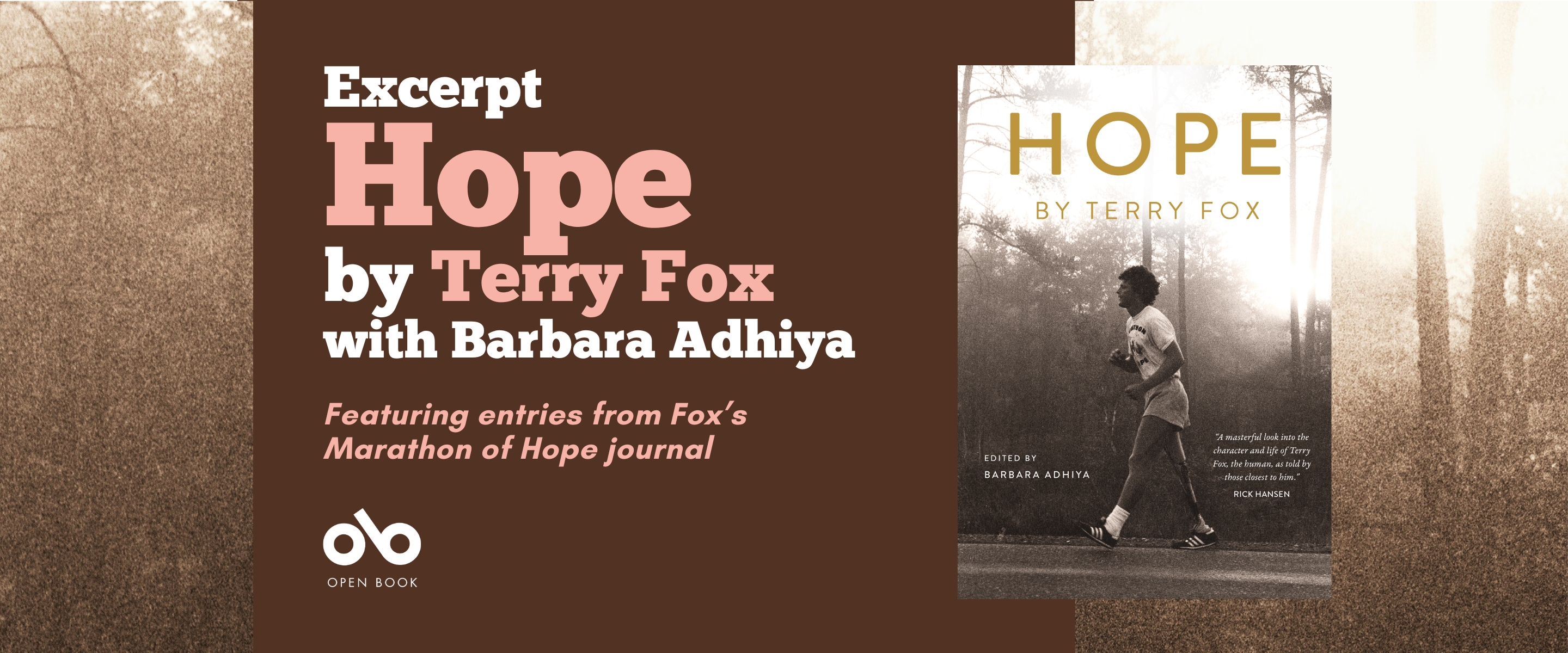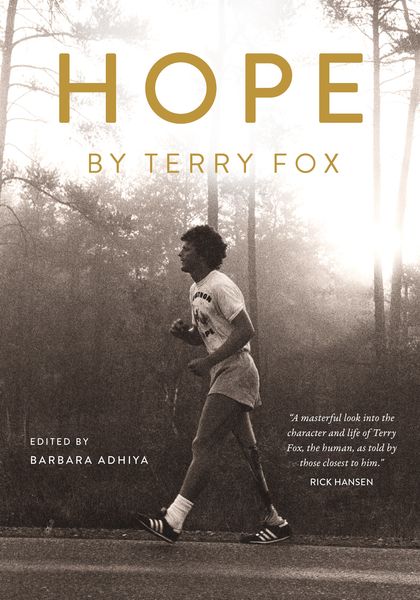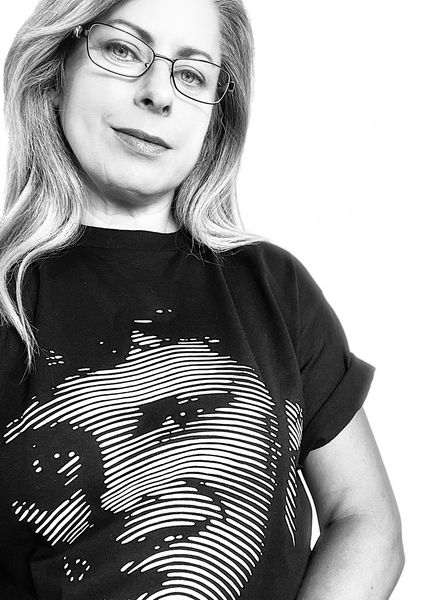Read an Excerpt from Hope, the New Terry Fox Biography edited by Barbara Adhiya
We're beginning the Fall 2024 publishing season on a note of hope and inspiration today, as we share an excerpt from the powerful new biography on Terry Fox. With the latest edition of the Terry Fox Run coming up on September 15th, this is a timely reminder of an unforgettable act of bravery and a national hero who continues to live on in Canadian history and culture.
As a young man of just eighteen years old, Fox was diagnosed with osteosarcoma and his right leg was amputated just above the knee. His response was to embark on a mission to help cure cancer so that other people who not have to suffer the disease. This led to the Marathon of Hope, a legendary run across Canada from St. John's, Newfoundland to Victoria, British Columbia. The journey would be 5,300 miles in total, from coast to coast, with Fox setting out on April 12, 1980.
Though it began more quietly, and Canadians were initially unsure what to make of this monumental undertaking, enthusiasm and support quickly built throughout the nation as Fox ran from province to province. His endeavour became a national and international story, whipping followers and a captivated audience into a frenzy over the 3,339 miles that Fox eventually was able to complete before his cancer sadly returned and halted the run. Fox passed away from the disease the following year, but the spark was lit to continue his legacy annually, and the annual Terry Fox Run has even spread to cities around the world, raising more than $850 million to date — well over Terry’s goal of one dollar for every Canadian.
Through a series of interviews with those who knew Fox closely - ranging from his siblings, nurses, and coaches to volunteers during the Marathon of Hope - editor Barbara Adhiya discovered exactly what is took to run a marathon each day, using these stories and entries from Fox's personal journal to capture the resilience and fortitude that went into this heroic action. It's a book that shows how the impossible can be made possible with enough hope and support.
Read an Excerpt from Hope, the New Terry Fox Biography by Barbara Adhiya
Dick Traum
First runner with a prosthetic leg to complete a marathon; founder of Achilles International
I interview Dick over Zoom. He is an energetic man and a spirited grandfather, happy to share what he knew of Terry and what Terry had done for him. Their lives intertwined in a crucial way, yet they never actually met.
Dick Traum was featured in a Runner’s World article in 1977 for running in the New York City Marathon as an amputee. It was this article that showed Terry he could still be active without one leg and sparked the idea of running a marathon. Dick first heard about Terry when a radio station called to tell him about Terry’s Marathon of Hope and that he had been his inspiration. Dick thought that was nice but didn’t think much more of it.
It wasn’t until Terry passed away that Dick realized how special his story was and how it had affected so many people. Dick had inspired Terry, but as fate would have it, Terry returned the favour and inspired Dick to create Achilles International, an athletic community for disabled athletes. In 1981, during the first year of the Terry Fox Run, Dick was invited to Vancouver to participate.
What had happened — this is very, very important — is that I was in Canada. He’d passed away, and they had these Terry Fox Runs [all around the country]. I think the first one was in September of 1981, and I was invited. I was honoured to be invited to do some of the runs and to help them raise money. I thought what he had done was a good thing, and Canadians were probably a generation ahead of the Americans in terms of the comfort level that they had with disability. When I was there, people would ask me, “How did you lose your leg? Does it hurt?” Very, very normal, natural things. And then when I started running, it wasn’t like, “Oh, I don’t wanna get too close to him. Maybe it’s contagious.” They were the most comfortable, and I had never seen anything like that before in my life. And I felt very good about it.
After seeing the difference in how disabled people were treated in Canada, Dick felt it could be done in the U.S. He was inspired by Terry’s ability to bring people together, to take on a challenge, to create a community of like- minded individuals.
Your CanLit News
Subscribe to Open Book’s newsletter to get local book events, literary content, writing tips, and more in your inbox
In 1982, Dick started an eight-week course to encourage people with disabilities to run. Terry’s older brother, Fred, attended the first meeting. Being supportive, Fred said to him that if just three people show, it would be a success. Two people showed up. Undeterred, Dick kept at it, talking to anyone he could find.
[People] would go to a place called Bryant Park and buy marijuana. Here’s a kid, probably eighteen years old, selling marijuana and was an amputee on crutches. I went over to him and said, “Hey, you should join this group.”
So, he joins the group, and I would pay for his subway fare to get there. I would find people one at a time, and by the end of the eight-week program, we had about half a dozen people who were participating.
Their first run was a five-mile run in Central Park, and they slowly built their mileage. Dick decided to change the course into a running club, and someone suggested the name Achilles.
The beauty of Achilles was he was an athlete but also a person with a disability. And we called it the Achilles Track Club, and we ran, and we held workouts twice a week. By November — this is in January — we had six people who were successful enough to enter the marathon. So, we had six people doing the 1983 New York City Marathon, and myself. I was very, very proud of that. And then in 1983 we exploded — we doubled to thirteen people. And then the following year, we had twenty-five people.
And the club continued to grow. Brian Froggatt, an above-knee amputee in New Zealand, had seen him on TV, and Dick coached him by phone.
While Dick was proud to have run the New York City Marathon in six hours and forty-four minutes, Brian came and did it in four hours and fifty-four minutes in 1985. Brian then helped set up a chapter in New Zealand. Dick would provide support to anyone who needed it, whether that be a handshake, a T-shirt, or a hug. Now, Achilles International has members and chapters in over seven countries, including Canada.
When you achieve something, you go ahead and you set a new goal, and I call this addiction to achievement. And what I’ve been doing over many, many years is I have been addicting people to achievement.
Through their remarkable achievements, Dick and Terry spread the message that the impossible can be made possible, but it’s easier with a community. It starts with belief, and the more you accomplish some- thing that wasn’t thought possible, the greater that joy can be.
We’re dogmatic [at times]. So, I tell this story: I lost the leg and see a psychologist and the psychologist says, “Well, it’s a shame, but it really isn’t that big a deal. There’s basically nothing that you will not be able to do because you lost a leg.” I said, “Not correct.” He said, “Give me an example. I’ll turn it around. I’ll show you it’s the truth.” So, I said, “I’ll never beat Frank Shorter in the marathon.” So, in 1977, I’m running and Frank Shorter’s running [the] New York [Marathon], and he drops out at sixteen miles. And I finish. So, I beat Frank Shorter in a marathon. The Road Runners have this hall of fame, and I was honoured, and they asked me to speak. I tell this story, and Frank Shorter is in the audience, and everybody’s looking at him. What’s he gonna say? But the important point here, and Terry would have loved this, is that it’s funto do the impossible.
Terry had a team of people who not only gave him the insight and tools needed to overcome his obstacles but also made it fun for him, sometimes running or biking alongside him. Dick recalls doing the same for a newer member of the running club.
Someone who had a stroke came out, a young little lady. She really didn’t look like she could do very much. There are lampposts in Central Park, and I said, “Look, let’s run, let’s move from one lamppost to the next.” And she did it. And I said, “You want to try another lamppost?” And she did. And she was smiling. I said, “Should we go for three?” and she said, “Yeah.” And she went three lampposts and I said, “Turn around.” So, she did it, she looked and said, “My goodness gracious,” looking at how far she had gone. Three lampposts [there and back] is probably a hundred yards, and she’d never done that much distance in her life. And she was able to do that, taking her time, but she had achieved. We call it lamppost running, and the idea is that you start somewhere, and if you could do three lampposts, maybe next time you can do five lampposts. So she built [on it and went] from doing three lampposts to running twenty-two marathons. I say “running”; you know, it was very slow. She used a cane, but she completed twenty marathons. Along the way, she says, “What else can I do? What can I do next?” Somehow, she got involved with fencing, and she became a good fencer, and she was in the Paralympics as a fencer representing Brazil, her native country.
Dick is a strong believer in community because he knows the power of motivation when you’re in a group. Groups can inspire, but they also give you a boost of positivity. When you’re with like-minded people in the same situation as you, you can believe in what’s possible because you are seeing that belief in others, and the fear and the feeling of impossibility diminish. Negativity from others can also become an incentivized challenge — from “you can’t do that” to “watch me!”
The trick on this is, very honestly, the group. In other words, if you go ahead and run a hundred miles, there’s nobody there to notice it. It doesn’t really do much. The feedback from others is very, very important. This is what helped Terry because [when] he was out there, he was getting raves from the crowd. He was getting energy from the group.
It’s very normal for people to have stressful situations. Everybody goes through this, [like the] loss of a job: what do you do? Ideally, you try this, you try that, you send out some resumes, you see people. And the trick is can you get to be with other people, in a situation where [you] can talk, bond, [and] help each other?
I inspired [Terry], but then he inspired me, and this would have never happened without that — thousands of marathoners a year with disabilities. There are all kinds of stories, thousands of stories, and had I not helped Terry, [they] would have never, ever happened.
*A note from Barbara, editor of Hope by Terry Fox:
Unfortunately, Dick passed away in January of this year. I'm so grateful that he took the time to share his stories with me and I wish he had gotten to see his part in the finished book.
___________________________________________________
Barbara Adhiya is an editor and author based in Toronto. She was an editor at CP/AP and Reuters. She was a contributing author for Making It in High Heels 3: Innovators and Trailblazers and was an editor for Expect Miracles by Dr. Joe Vitale.






